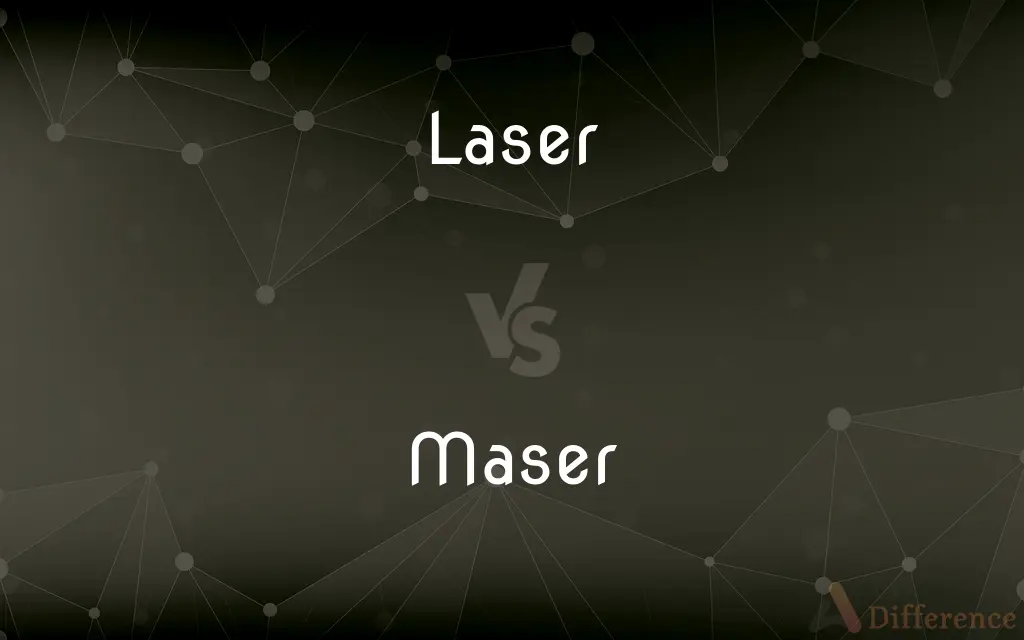Laser vs. Maser — What's the Difference?
By Fiza Rafique & Maham Liaqat — Updated on March 28, 2024
A laser emits light through optical amplification, utilizing visible or near-infrared light; a maser, however, amplifies microwave radiation, operating in the radio frequency range.

Difference Between Laser and Maser
Table of Contents
ADVERTISEMENT
Key Differences
Lasers work by stimulating electrons in a medium (like a gas, liquid, or solid) to emit light at specific wavelengths, creating a narrow and highly focused beam of light. This process, known as stimulated emission, results in coherent light that can be visible or invisible to the human eye, depending on the laser. On the other hand, masers operate on the same principle of stimulated emission but use molecules or atoms that emit microwave radiation instead of visible light. This makes masers particularly useful in applications requiring precise amplification of radio frequencies, such as atomic clocks, radio astronomy, and deep-space communication.
Lasers are widely used in various applications, including medical devices, barcode scanners, and fiber-optic communication systems. While lasers are common in everyday technology, masers are more specialized, often found in scientific research and aerospace applications.
The output of a laser can range from very low power, like in laser pointers, to extremely high power in industrial and military lasers. The versatility in power output allows lasers to be used for delicate surgeries as well as cutting through steel. Whereas masers, typically operating at lower power levels, are crucial in applications where stability and low noise are paramount. Their ability to amplify weak signals without significant noise addition makes them indispensable in sensitive measurements and communication links.
Lasers are often visible to the human eye, with colors depending on the medium used (e.g., red from a helium-neon laser, green from a solid-state laser). This visibility makes lasers ideal for applications requiring precision and visibility, such as in surgery or entertainment. Masers, emitting in the microwave range, are inherently invisible and do not have this visual utility. However, their invisibility does not detract from their value in non-visual applications, demonstrating the complementary nature of lasers and masers across the electromagnetic spectrum.
Comparison Chart
Type of Radiation
Visible or near-infrared light
Microwave radiation
ADVERTISEMENT
Applications
Medical devices, barcode scanners, communication
Atomic clocks, radio astronomy, deep-space communication
Visibility
Often visible to the human eye
Invisible to the human eye
Power Levels
Ranges from very low to extremely high
Typically operates at lower power levels
Utility
Precision in surgery, entertainment
Stability and low noise in sensitive measurements
Compare with Definitions
Laser
A device that generates a concentrated beam of coherent light.
The surgeon used a laser for the delicate eye operation.
Maser
A device that amplifies microwave radiation through stimulated emission.
The maser is crucial in deep-space communication antennas.
Laser
Employed in measuring distances accurately via laser rangefinders.
The architect measured the room size using a laser.
Maser
Involved in quantum computing as part of the control mechanism.
Masers help stabilize quantum bits in a computer.
Laser
A tool for cutting or welding materials with precision.
Lasers cut the metal sheet with high accuracy.
Maser
Applied in scientific experiments requiring low-noise amplification.
The laboratory maser amplified the weak signal without adding noise.
Laser
Utilized in optical storage devices to read and write data.
Lasers in DVD players read data from discs.
Maser
Used in atomic clocks for precise timekeeping.
The atomic clock employs a maser for unparalleled accuracy.
Laser
Used for entertainment in light shows.
The concert featured an impressive laser light show.
Maser
Enhances the sensitivity of radio telescopes.
Astronomers use masers to detect faint cosmic signals.
Laser
A laser is a device that emits light through a process of optical amplification based on the stimulated emission of electromagnetic radiation. The word "laser" is an acronym for "light amplification by stimulated emission of radiation".
Maser
A maser (, an acronym for microwave amplification by stimulated emission of radiation) is a device that produces coherent electromagnetic waves through amplification by stimulated emission. The first maser was built by Charles H. Townes, James P. Gordon, and Herbert J. Zeiger at Columbia University in 1953.
Laser
Any of several devices that emit highly amplified and coherent radiation of one or more discrete wavelengths. One of the most common lasers makes use of atoms in a metastable energy state, which, as they decay to a lower energy level, stimulate others to decay, resulting in a cascade of emitted radiation.
Maser
A device that generates or amplifies electromagnetic radiation, especially microwaves, of a coherent wavelength by stimulated emission.
Laser
A beam of radiation emitted by a laser.
Maser
A natural object or region of space that acts like a maser, as a star-forming region of intersellar space.
Laser
(Sports)A ball or puck sent in a straight line at high speed
Shot a laser into the upper right corner of the goal.
Maser
(physics) a device for the coherent amplification or generation of electromagnetic radiation (especially of microwave frequency) by the use of excitation energy in resonant atomic or molecular systems
Laser
A device that produces a monochromatic, coherent beam of light.
Maser
(astronomy) Any celestial object that generates microwaves using the same method
Laser
A beam of light produced by such a device; a laser beam.
Maser
Obsolete spelling of mazer
Laser
A laser printer.
Maser
Same as Mazer.
Laser
A gum resin obtained from certain umbelliferous plants.
Maser
An electronic device producing coherent monochromatic microwave radiation; it produces less noise than other forms of microwave oscillator.
Laser
Such a plant.
Maser
An acronym for microwave amplification by stimulated emission of radiation; an amplifier that works on the same principle as a laser and emits coherent microwave radiation
Laser
To cut with a laser.
Laser
(sports) To throw or kick with laser-like precision.
Laser
A device which produces an intense, usually narrow, monochromatic beam of coherent light; called also optical maser. It has various forms, and is used in various applications in science and technology. The beam is produced by boosting the majority of the electrons in specific radiation-absorbing atoms in a medium into a higher energy level, from which they are stimulated by their own emitted radiation to drop back synchronously to their lower energy level, and emit light which is in phase (coherent).
Laser
An acronym for light amplification by stimulated emission of radiation; an optical device that produces an intense monochromatic beam of coherent light
Common Curiosities
What is the primary difference between a laser and a maser?
The primary difference is that lasers emit light in the visible or near-infrared spectrum, while masers emit microwave radiation.
Are masers visible to the human eye?
No, masers operate in the microwave part of the spectrum and are invisible to the human eye.
Can a laser cut through metal?
Yes, high-power lasers can cut through metal and are used in industrial applications for precise cutting.
Can lasers be used in medical applications?
Yes, lasers are widely used in various medical applications, including surgery and vision correction.
What makes masers important in astronomy?
Masers are important in astronomy for their ability to amplify weak radio signals from space without adding significant noise, aiding in the study of the universe.
What role do masers play in quantum computing?
Masers are used in quantum computing to help stabilize quantum bits (qubits) and control quantum states with precision.
What is the significance of masers in atomic clocks?
Masers provide the stable and precise frequency standards necessary for the accurate timekeeping in atomic clocks.
Do lasers only produce visible light?
No, lasers can produce light across a wide spectrum, including ultraviolet and infrared, though not all are visible to the human eye.
Are lasers used for communication?
Yes, lasers are used in fiber-optic communication systems to transmit data over long distances at high speeds.
Can masers be used for communication?
Yes, masers can amplify weak signals in communication systems, especially in deep-space communication.
How do masers differ in application from lasers?
Masers are primarily used in scientific, aerospace, and research settings for their precision and stability, whereas lasers have a broader range of applications including medical, industrial, and entertainment.
Is the technology behind lasers and masers similar?
Yes, both lasers and masers operate on the principle of stimulated emission, though they differ in the type of electromagnetic radiation they amplify.
How do lasers work?
Lasers work by stimulating electrons in a medium to emit photons in a coherent beam of light through the process of stimulated emission.
What are the safety concerns with laser use?
Laser safety concerns include eye damage and burns, necessitating proper safety measures and equipment during use.
What advancements have been made in laser technology?
Advancements in laser technology include the development of more efficient, powerful, and compact lasers for a variety of applications across different industries.
Share Your Discovery

Previous Comparison
Seek vs. Find
Next Comparison
Quenching vs. TemperingAuthor Spotlight
Written by
Fiza RafiqueFiza Rafique is a skilled content writer at AskDifference.com, where she meticulously refines and enhances written pieces. Drawing from her vast editorial expertise, Fiza ensures clarity, accuracy, and precision in every article. Passionate about language, she continually seeks to elevate the quality of content for readers worldwide.
Co-written by
Maham Liaqat














































